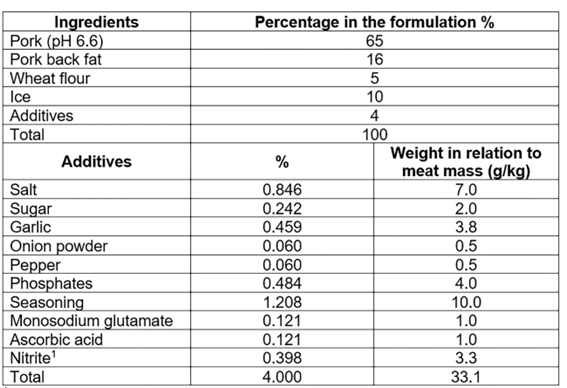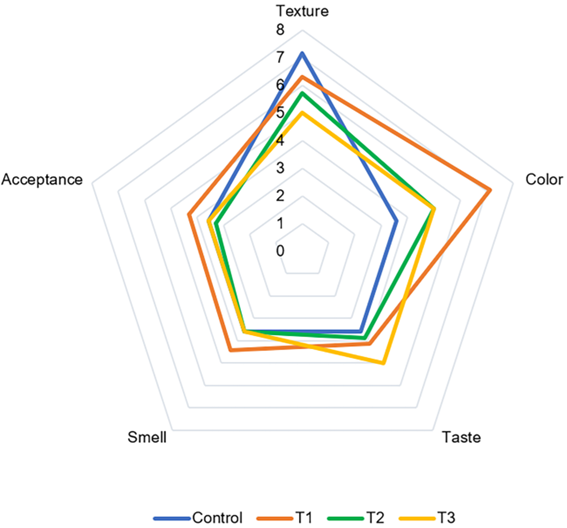INTRODUCTION
In recent years, world agricultural production has seen a significant increase in the harvest of tropical fruits, especially in countries located in tropical and subtropical areas of the planet. According to data provided by the FAO, it is estimated that 99 % of tropical fruit production occurs in developing countries (FAO, 2019). Colombia, with is geographic, climatic and biological diversity, forms different ecosystems, which allows the production of a wide variety of plant species throughout the year (Rodríguez-Leyton, 2019). Papaya (Carica papaya L.) is one of the fruits with the highest production and consumption, which generates in its agro-industrial transformation a large quantity of by-products that are generally disposed of as organic waste (Lopera Mesa et al. 2009; Ovando-Martínez et al. 2018; Pathak et al. 2019). Different studies have shown that papaya residues basically the epicarp, is an excellent source of multiple antioxidant compounds, phenolics, various vitamins, and specially carotenoid pigments (Ordóñez-Santos et al. 2014; Dorado et al. 2017).
Eating food rich in natural antioxidants helps protect cells from oxidative-type damage caused by free radicals, leading to a lower risk of cardiovascular disease, various types of cancer and some degenerative and neurological diseases (Ahmad et al. 2015). This growing demand for the consumption of natural and healthy foods has forced the food industry to include antioxidants in various product, as seen in meat products. Natural antioxidants include carotenoid pigments, which are fat-soluble compounds responsible for the natural yellow, orange and red color fruits, in vegetables and plants (Pinzón-Zárate et al. 2015). Additionally, they protect cells from the oxidative damage caused by freed radicals, reducing the risk of developing catastrophic diseases (Ahmad et al. 2015). These antioxidants are beneficial in the production of meat products since various additives, nitrates and nitrites, among others, are generally added in order to increase preservation times or improve organoleptic properties (color, smell and taste), in addition to preventing some oxidative processes. However, the presence of these chemicals in meat products has led to some consumer rejection because these substances are deemed harmful to humans. Nitrites combine with secondary or tertiary amines to form N-nitroso derivatives, and some of these derivate have been shown to accelerate the development of diseases such as cancer according to studies carried out at the laboratory level (Gassara et al. 2016). For this reason, the global trend at the research level is to look for naturally-derived compounds that can fulfill a conservative function in meat products, extending shelf-life and maintaining sensory properties without harming consumer health.
Multiple studies have developed based on the use of plant-based resources as a source of functional compounds in the meat industry: turnips (Brassica rapa) (Carvajal-Macías et al. 2019), preconverted nitrites from spinach, lettuce, celery and beets (Hwang et al. 2018), celery powder, purple sweet potato powder, red gardenia and paprika powder and cranberry (Jin et al. 2018), beet powder (Sucu & Turp, 2018), parsley extract powder (Riel et al. 2017) and dry red grape pomace (Riazi et al. 2016). However, no studies have been reported from lipid extracts from papaya epicarp as an alternative source of carotenoid pigments with applications in the manufacture of meat products in order to reduce the presence of nitrites in these products. Therefore, there is potential for a new field of research aimed at establishing the agro-industrial valuation and the technical and economic benefits on the potential use of papaya by-products as a source of natural dyes in the meat industry.
Therefore, the objective of the present study was to evaluate the agro-industrial potential of lipid extracts from papaya epicarp as a partial substitute for nitrites in Frankfurt sausages, in addition to evaluating stability over time to ensure that physicochemical, nutritional and sensory properties were not affected.
MATERIALS AND METHODS
Materials. This research was carried out at the Laboratorio de Tecnología de Carnes and the Laboratorio de Frutas y Hortalizas of the Universidad Nacional de Colombia - Palmira. Papaya residues from fruits in maturity grade 5, composed of epicarp and small mesocarp adhesions, were acquired at different points of sale in the market in the city of Palmira, Valle del Cauca, Colombia. The samples were selected by excluding material with mechanical damage, dark areas or abnormal coloration and were immersed in a hypochlorite solution at 150 ppm for 20 minutes and washed with abundant potable water. Subsequently, they were placed in vacuum-sealed polyethylene bags using an EGARVAC SCP BASIC B devise (Vacarises, Barcelona, Spain) for freezing at -30 ± 2 °C for 24 hours.
To obtain the extract, the material was subjected to freeze drying under a vacuum pressure of 0.120 mBar and at condenser temperature of -80 °C for 24 h using a LABCOMCO, USA, 18 L tray lyophilizer. Subsequently, the dry material was ground using an IKA M.20s#, USA, grinder with a 3 mm diameter hole and screened in a Rotap (M® PS-35, Series 1329, Colombia) for 15 minutes, obtaining 0.074 mm particles. The carotenoid pigments were extracted with ultrasound, obtaining an oil-based extract, for which neutral sunflower oil was used according to the methodology proposed by Ordóñez-Santos et al. (2015). Finally, the oily papaya epicarp extract (PEE) was added to a meat matrix (Frankfurt sausages) at different concentrations, with a sample without the extract as a control sample (Table 1).
Frankfurt sausage elaboration. Pork meat (pH 6.6) and commercial quality pork back fat purchased from a supermarket in the city of Palmira, Valle del Cauca, Colombia were used to make the sausages. The other supplies and additives used in the formulation of the sausages were purchased in supermarkets in the same city. The formulation and procedure for making the sausages were adjusted to the provisions of Colombian Technical Standard NTC 1325 (ICONTEC, 2008) and were taken from Pinzón-Zárate et al. (2015), as seen in table 2.
The emulsion was prepared using a CM14PGZ Mainca (Barcelona, Spain) cutter with a capacity of 9 kg. The sausages were made with a 23-gauge Amicel® artificial sleeve and tied at a length of 12 cm, which guaranteed an average weight of 60 g per sausage. The processed sausages were subjected to a heat treatment (scalding at 72 °C - internal temperature of the sausage, for 6 minutes) to achieve coagulation of the protein and stability of the emulsion. Said sausages were packed in vacuum polyethylene bags using an EGARVAC SCP Basic B devise (Vacarises, Barcelona, Spain) and refrigerated (3 ± 2 °C) for 72 hours until the respective analyses.
Physicochemical determinations. For each analyzed treatment, the dry matter, protein, ether extract, ash and carbohydrates were determined in triplicate with a proximate analysis according to AOAC methods (AOAC, 2016). Additionally, the caloric value was determined according to the Berthelot-Malher calorimetric pump method cited by Fabbri et al. (2000).
The pH measured in the sausages of each treatment was performed with a METTER TOLEDO MP 230 Switzerland digital pH meter according to the methodology proposed by Dzudie et al. (2002).
The water holding capacity (WHC) for each sausage treatment was determined according to methodology proposed by Dzudie et al. (2002). A 0.5 g sample of each sausage was placed on a grade 1 filter paper under a pressure of one kilogram, exerted by two plexiglass plates, for 20 minutes. The area of the pressed sausage and the liquid extracted from it were determined using ImageJ software (Image J® 1.40 g, Wayne Rasband, National Institutes of Health (USA)) (Pietzsch et al. 2012). The water holding capacity (WHC) was determined with the equations 1 and 2.
Where, S1 - total surface area, S2 - area of the pressed sausage, ω - total moisture of the sausage sample, WHC - water holding capacity.
To determine the stability of the emulsion, 6 g of the meat emulsion were taken directly from the cutter and placed in previously weighed 16 ml centrifuge tubes. The tubes were heated at 75 ± 1 °C for 30 minutes and centrifuged at 2100xg for five minutes according to Choe et al. (2013). Finally, the stability of the emulsion was calculated using the equation 3.
Where, Ee - Stability of emulsion (%), ω1 - Weight of the meat emulsion mass in the tube after draining the lipid layer, ω2 - Weight of the meat emulsion mass in the tube before heating.
The water activity of each sausage treatment was measured according to AOAC standards (AOAC, 2016) with the help of an AquaLab 4te. USA, hygrometer.
Determination of the texture profile. The methodology proposed by Savadkoohi et al. (2014) was used with a universal texturometer, SHIMADZU TESTER EZTestEZ-S (Tokyo, Japan). A 15 mm thick slice was taken from each sausage and placed in the middle of two parallel axial plates, which were compressed 50 % at a speed of 60 mm/min with no waiting interval between the two compressions. The hardness, cohesiveness, elasticity, chewiness, adhesiveness and gumminess were measured.
Determination of the color coordinates CIEL*a*b*. The color coordinates were determined at five different points following the methodology proposed by Ordóñez-Santos et al. (2015). A KONICA MINOLTA METER CR-100 (Osaka, Japan) model colorimeter, was used. Illuminant D65 with an 8 mm measurement and 2° observation angle, were used (equipment calibrated with a white ceramic plate with reference values Y = 89.5, x = 0.3176 and y = 0.3340). Three 5 cm long cylindrical samples were taken, making a longitudinal cut to analyze their internal color. The color measurements were expressed in terms of luminosity L* (L* = 0 for black and L* = 100 for white) and the chromaticity parameters a* (green [- ] and red [+ ]) and b* (blue [- ] and yellow [+ ]). Based on these parameters, the hue or pitch angle (h°) and the chromaticity or saturation index (C) were calculated using the equations 4, 5 and 6.
The difference in the total color (∆E) was calculated with the following equation:
Sensory evaluation of processed sausages. The sensory characteristics of the different sausages were evaluated with the qualitative parameters smell, color, taste, texture and acceptability. The panel was used on day zero of storage and, for the evaluation, the different sausages were cut into 1.5 cm long and heated with steam (140 °C) for five minutes and offered to the panelists on white plastic trays under natural lighting and at room temperature. Each treatment was identified with random three-digit numbers so that they did not provide any information to the evaluators. A satisfaction degree test was applied to 70 untrained panelists of both sexes and aged between 17 and 65 years. Prior informed consent was obtained from the participants. A survey with a seven-point unstructured hedonic scale was used (1 = I dislike it very much and 7 = I like it very much) (Duizer & Walker, 2016; Baba et al. 2016).
Evaluation of the stability of sausages over storage. The stability of the sausages with PEE with the best physicochemical and sensory characteristics was evaluated. For this, the proximate analysis and the color coordinates were measured on days 0, 10, 20 and 30 of storage of the sausages, vacuum-packed and refrigerated (6 ± 2 °C); the analysis was performed for the residual nitrite content and lipid oxidation at 0, 15 and 30 days of storage under the same packaging and refrigeration conditions. All measurements were made in triplicate and are presented as mean value ± standard deviation.
The proximate analysis, at different evaluation times, was performed according to the methods established by the AOAC (AOAC, 2016). Likewise, the measurements of the color coordinates were carried out under the same conditions. The determination of the residual nitrite was carried out according to the methodology proposed by Zahran & Kassem (2011).
For the determination of lipid oxidation on the evaluation days, the analysis of the reactive substances to 2-thiobarbituric acid reactive substances - TBARS (Ke & Woyewoda, 1979), substances that from as a secondary by-product of lipid peroxidation, including malondialdehyde (MDA). The value of p-anisidine was also quantifies according to method proposed by Osawa et al. (2008), which measures the oxidative state of lipids, in relation to the quality of flavor. In addition, the peroxide index was determined according method proposed by Dermis et al. (2012), which measures the initial oxidation state or formation of primary products of lipid oxidation.
Experiment design. A sample randomized design was used for the first part of the study, while a randomized block design was applied to determine the stability of the sausages during storage; each treatment had three replications. The level of significance for all treatments was determined with ANOVA analysis of variance, with a significance level of 5 %. The difference between the means of the treatments was determined using the Tukey test, with a probability for significant differences of p <0.05. A statistical analysis was performed with SPSS Statics 19, 2020.
RESULTS AND DISCUSION
Physicochemical properties of Frankfurt sausage. The results of the proximate analysis, the caloric value and the physicochemical properties did not show significant differences (p <0.05) (Table 3). It was observed that the addition of the oily PEE did not influence the chemical and nutritional characteristics of the different treatments. These results were agree with those presented by Marchetti et al. (2015), who worked with lean reduced sodium sausages with fish oil, optimized for a mix design approach. The pH values were than those of Chattopadhyay et al. (2019) (pH = 6.55 on average), who worked on fish sausages with a vegetable gel enriched with chitosan; however, the WHC value was slightly higher than the results presented by the same author (WHC = 91,41 % on average). Likewise, the data provided by Wang et al. (2019) in sausages made with beef and mushrooms (Lentinula edodes) presented higher pH values (pH = 6.65), but the water activity was similar to that found in this study (Aw = 0.98). The research presented by Xiang et al. (2019) for sausages with mulberry extract (Morus alba) showed a pH value = 5.93, slightly higher than that found in this study. Finally, the data presented by Savadkoohi et al. (2014) for sausages with bagasse tomato peels showed similar values to those obtained in this study for both and WHC (pH = 5.48, WHC = 88.22%). The different values found for the physicochemical properties are attributed to the characteristics of the plant substances added in each case, whose chemical composition in highly varied.
Table 3 Proximate analysis, caloric value and physicochemical properties of the different processed sausage treatments.
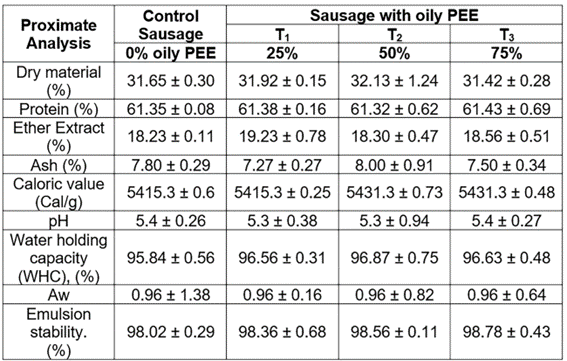
PEE - Papaya epicarp extract
T1 - 25 % oily PEE, T2 - 50 % oily PEE. T3 - 75 % oily PEE
The results are the average of three repetitions and are shown as mean ± standard deviation (n = 3)
Textural and color coordinates of Frankfurt sausage. The result of the texture profile and the surface color coordinates of the analyzed sausages are shown in table 4. Statistically differences were evident in the elasticity and gumminess values, while for the rest of the parameters there were no variations in the texture of the different sausages. These differences could be attributed to the size of the fat globules since this factor is strongly related to the texture with large globules that reduce the adhesion between the proteins and the cellulose and the proteins present in the meat emulsion (Toledo et al. 2016).
Table 4 Texture profile and color coordinates of the analyzed sausages.
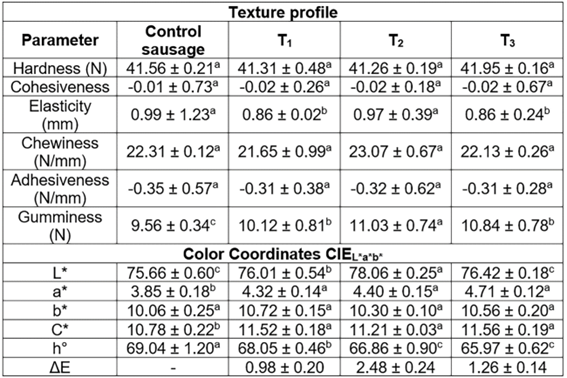
L*: 0 = black and 100 = white; a*: -60 = green and +60 = red; b*: -60 = blue and +60 = yellow; h - pitch angle: 90° = yellow, 180° = green and 0° = red; C - saturation index, distance from the coordinates at the origin to the determined color point.
T1 - 25% oily PEE, T2 - 50% oily PEE. T3 - 75% oily PEE
The results are the average of three repetitions and are shown as mean ± standard deviation (n = 3)
a - c Averages within rows with different letters are significantly different (p <0.05)
In a study by Ozaki et al. (2020), sausages with two concentrations of mixture of radish powder and chitosan (0.5 % radish powder + 0.25 chitosan and 0.5 % radish powder + 0.5 chitosan) had higher values for all parameters except adhesiveness. The research developed by Rosero-Chasoy et al. (2018)on pork sausages with yacon peel flour lower values than this study for hardness (28.32 N), elasticity (0.41 mm), chewiness (3.58 N/mm) and adhesiveness (-0.52 N/mm), while for cohesiveness (0.30), the value was higher. The variations in the different studies are attributed to the composition of the sausages and, in particular, to the type and content of fats and the greater or lesser amount of water and hydrocolloids used in their preparation, which affect texture, making them harder or softer.
For the color coordinates, statistical differences were evident in the L*, a*, C* and h° parameters, white the b* parameter showed no changes in relation to the control sausage. The L* light intensity was higher in treatment two (T2), followed by treatment three (T3) and finally treatment one (T1). These data differ from those provided by Amensour et al. (2010) who worked with chicken sausages with an aqueous extract of Myrtus communis, finding a decrease in luminosity as the concentration of the extract increased.
The data presented by Afoakwah et al. (2015) showed values similar to those found in this study for sausages with lyophilized Jerusalem artichoke powder (Helianthus tuberosus L.). The different variations in luminosity are attributed to the fact that the concentration of the pigments does not contribute to luminosity but is related to a high presence of bound water and fats that predominate in light spaces, decreasing the oxidation capacity of myoglobin. For the a* and C* coordinates, a significant increase directly proportional to the increase in the concentration of oily PEE was observed. The highest values were 4.71 and 11.56, respectively (for treatment T3), which means an increase of 22.33 % for coordinate a* and 7.24 for C*. These values differ from those presented by Pinzón-Zárate et al. (2015) for sausages with oily extract of chontaduro palm fruits (Bactris gasipaes) and by Rosero-Chasoy et al. (2018) for sausages with yacon peel flour (Smallanthus sonchifolius), studies in which the value of coordinate a* was lower than in the control sausage. For chroma, the results of the present study were like those presented by Rosero-Chasoy et al. (2018) for sausages with yacon peel flour, by Savadkoohi et al. (2014) for pork sausages with tomato peel bagasse and by De Souza Paglarini et al. (2019) for bologna-type sausages with a gel prepared from soybean oil.
In general terms, the addition of plant-based flour to meat products leads to a decrease in the red color of the meat because of the reactions that occur, hindering the formation of oxymyoglobin; however, in the case of the PEE, an increase is noted because of its own coloration, which is an intense red-orange color because of the presence of α and β carotene, β-cryptoxanthin and lycopene fractions (Velasco-Arango et al. 2019), the formation of nitrosomyoglobin and loss of moisture, which favor an increase in the concentration of the heme pigment and the development of the normal coloration of emulsified meat products such as Frankfurt sausages. For the b* coordinate, the values for all treatments were in a range between (10.06 - 10.74, including the control sausage) without showing statistically significant differences. The lowest value was obtained for treatment T1 (0.98), sausages with 25 % PEE.
Sensory evaluation of processed sausages. The texture, flavor, smell and acceptance attributes (Figure 1) were not affected by the addition of PEE for treatment T1, while T2 and T3 did show significant differences (p <0.05). The color was better in the T1 treatment (25 % PEE). These results agree with those presented by Hernández & Güemes (2010), who registered significant differences in sensory attributes in sausages made with orange epicarp flour.
The results showed that the sausages with better characteristics and better acceptance because of their physicochemical, textural, color and sensory properties were in the T1 treatment (25 % of PEE and 75 % of nitrites) which is why they were subjected to the stability analysis in the storage time.
The results of the proximate analysis (Table 5) for day 0 agree with the data obtained in the first part of this study (Table 3). When comparing the results from day 0 with day 30, no statistically significant differences were noted for any of the parameters of the chemical composition. However, for caloric values, a slight non-significant decrease was observed, probably represented by the decrease in lipid content.
Table 5 Proximate analysis, caloric value and CIEL*a*b* color parameters of sausages during storage time.
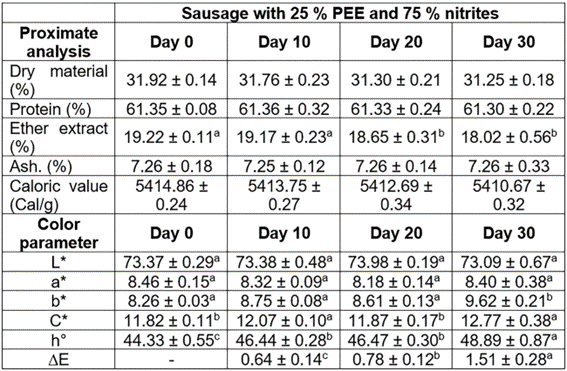
PEE - Papaya Epicarp Extract
T1 - 25 % oily PEE, T2 - 50 % oily PEE. T3 - 75 % oily PEE
L*: 0 = black and 100 = white; a*: -60 = green and +60 = red; b*: -60 = blue and +60 = yellow; h - pitch angle: 90° = yellow, 180° = green and 0° = red; C - saturation index, distance from the coordinates at the origin to the determined color point.
The results are the average of three repetitions and are shown as mean ± standard deviation (n = 3)
a - c Averages within rows with different letters are significantly different (p <0.05)
The CIEL*a*b* color parameters (Table 5) did not show significant differences (p <0.05) in the L* and a* coordinates, while the b*, C*, h° and ∆E parameters did differ with the increased storage time. The determination of color in meat products is not only considered a sensory parameter that determines the acceptance or rejection of a certain product but also shows the changes to which muscle tissue is subjected to during storage. As storage time increased, the ∆E color difference also increased, an increase attributed to isomerization of carotenoid pigments. Feng & Makino (2020) showed similar results in pork sausages at 68 days of storage. Similarly, Dong et al. (2020), working on vacuum-packed Harbin red sausages, also did not see significant differences in these coordinates during storage at room temperature over 12 days of observation. In relation to the attributes b*, C* and h°, an increase occurred after 30 days of storage, which is possibly attributed to enzymatic reactions and released moisture that favor alterations in hue and saturation of analyzed sausages. These data agree with those presented by Jin et al. (2018) who worked with sausages with different vegetables used as partial nitrite substitution, measured at four weeks of storage, and as stated by Armenteros et al. (2013) this increase may be due to the fact that the bioactive compounds in plant extracts promote the reaction between nitrite and muscle myoglobin, forming the pink pigment nitrosylhemochrome.
The analysis of residual nitrite (Table 6) showed a significant reduction during storage, which is attributed to the interaction that occurs between muscle myoglobin and nitrite converted to NO through an oxidation reaction and NO2 consumption generating NO, which is regulated in the active site of myoglobin, giving rise to the pink color in sausage thanks to the formation of nitrosomyoglobin. These results agree with those presented by Jin et al. (2018) for sausages with different types of vegetables at different concentrations, obtaining a decrease from 27.90 mg/kg to 17.22 mg/kg during four weeks of storage. Likewise, Šojić et al. (2019) showed a decrease of 24.60 mg/kg in pork sausages with coriander essential oil during fifteen weeks of storage. Finally, Deda et al. (2007) showed results similar to this study in frankfurters added with tomato paste, where the value of the residual nitrite after 33 days of storage was reduced from 34.75 mg/kg to 8 mg/kg. The data allowed us to conclude that the analyzed sausages complied with the provisions of Colombian Technical Standard NTC 1325 (ICONTEC, 2008), which allows for a maximum of 200 mg/kg in processed meat products.
Table 6 Results of the analysis of residual nitrite and lipid oxidation for the sausages during the storage time

The results are the average of three repetitions and are shown as mean ± standard deviation (n = 3)
a- c Means with different letters in the rows are significantly different (p <0.05)
In meat products, the oxidation of fats is one of the main causes of deterioration of quality, and, during storage, changes related to the transformation of intramuscular lipids occur, changes that make it possible to detect alterations in the primary and secondary metabolites of fat oxidation. As the storage time increased, all the measured values (peroxide index, p-anisidine value, total volatile bases and TBARS) increased (Table 6); in the first 15 days of storage, a statistically significant growth (p <0.05) occurred, which allowed us to conclude that fat oxidation is determinant during the first 15 days of storage. These results agree with those presented by Wen et al. (2019) and by Deda et al. (2007), who worked respectively with dry pork sausages and Frankfurt sausages where there was a significant increase in TBARS values in the first 12 and 33 days of storage, respectively.
The sausages formulated with the lipid extract of carotenoids obtained from papaya epicarp presented excellent physicochemical and sensory characteristics, with very good stability over time, wish established a potential use of these extracts in agri-food applications in the meat industry as an alternative that reduces nitrites by 25 % and also as natural colorants in sausages. An interesting alternative is proposed herein that minimizes the negative effect of the action of nitrites in meat products on human health by adding natural carotenoid pigments.















